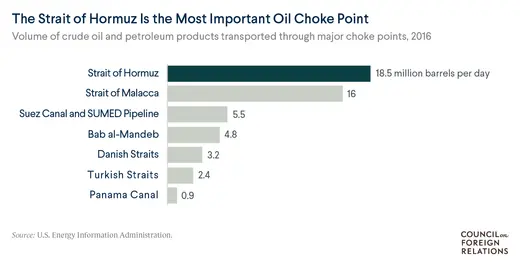The Strait of Hormuz: A U.S.-Iran Maritime Flash Point
The narrow and congested Mideast waterway has become a site of escalating U.S.-Iran tensions. Conflict in the wake of tanker attacks there could jolt global oil supplies.

By experts and staff
- Published
By
- CFR Editors
Escalating tensions between Iran and the United States have raised the prospect of a military clash in a waterway vital for global oil supplies. Close to one-fifth of the world’s crude oil is supplied by Gulf countries that rely on unimpeded travel through the Strait of Hormuz, which is twenty-one miles wide at its narrowest point and abuts southern Iran, to access world oil markets.

In April, Iranian officials threatened to close off the waterway as U.S. President Donald J. Trump ended sanctions waivers to importers of Iranian oil, effectively eliminating a vital source of revenue for Tehran. The United States has long considered freedom of navigation a vital interest, setting the stage for confrontation should Iran try to close the international waterway to shipping. During the Iran-Iraq War, U.S. naval ships escorted oil tankers through the strait, and in 1987 U.S. forces fired on Iranian forces laying mines in the Gulf, killing four sailors.

The United States deployed a carrier strike group to the region last month. Since then, there has been a series of attacks against oil tankers in the Gulf of Oman. U.S. Secretary of State Mike Pompeo attributed the most recent incidents to Iran but Iran denied responsibility, saying that “forces in the region and beyond are working hard to continue to create and escalate tension.”

While experts say it would be difficult for Iran to close the strait for a prolonged period, Iran has small boats that can interrupt shipping, as well submarines that can lay mines. It also has other means to disrupt the oil and gas exports of neighboring Arab countries. “The Strait of Hormuz is not the only theater the U.S. needs to worry about when it comes to defending the free flow of oil from the Middle East,” says Amy Myers Jaffe, CFR’s David M. Rubenstein senior fellow for energy and the environment, noting recent drone attacks and cyberattacks on Saudi oil and petrochemical infrastructure. “That is the challenge of escalating conflicts when it comes to the stability of oil markets.”